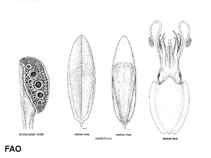Rhombosepion orbignyanum (Férussac, 1826)
Pink cuttlefish
Классификация / Names народные названия | синонимы | CoL | ITIS | WoRMS
Cephalopoda | Sepiida | Sepiidae
Environment: milieu / climate zone / пределы глубины / distribution range экология
демерсальный; солоноватоводный; пределы глубины 15 - 570 m (ссылка 1695), usually 50 - 250 m (ссылка 1695). Subtropical; 55°N - 17°S, 22°W - 36°E (ссылка 107081)
Distribution страны | регионы FAO | Ecosystems | места находок | интродукции
Eastern Atlantic and the Mediterranean: from Irish Sea to southern Angola.
Length at first maturity / Size / Weight / Возраст
половая зрелость: Lm 7.0, range 4 - ? cm Max length : 9.6 cm ML самец/пол неопределен; (ссылка 1695); 12 cm ML (female)
Краткое описание морфология
Life cycle and mating behavior половая зрелость | размножение | нерест | Eggs | Fecundity | Larvae
Основная ссылка
ссылки | координатор | соавторы
Jereb, P. and C.F.E. Roper (eds.) 2005 Cephalopods of the world. An Annotated and Illustrated catalogue of Cephalopod species known to date. Vol. 1. Chambered nautiluses and sepioids (Nautilidae, Sepiidae, Sepiolidae, Sepiadariidae, Idiosepiidae and Spirulidae). FAO Spec. Cat. Fish. Purp. 4(1):262p. Rome: FAO. (ссылка 1695)
Статус Красного Списка МСОП
(ссылка 130435: Version 2025-1)
Статус СИТЕС (ссылка 108899)
CMS (ссылка 116361)
Угроза для людей
Использование человеком
рыболовство: коммерческий
| FishSource |
инструменты
дополнительная информация
ресурсы в Интернет
BHL | BOLD Systems | CISTI | DiscoverLife | FAO(Publication : search) | Fishipedia | GenBank (Геном, Нуклеотид) | GloBI | Gomexsi | Google Books | Google Scholar | Google | PubMed | Tree of Life | Wikipedia (Вперёд, поиск) | Zoological Record



